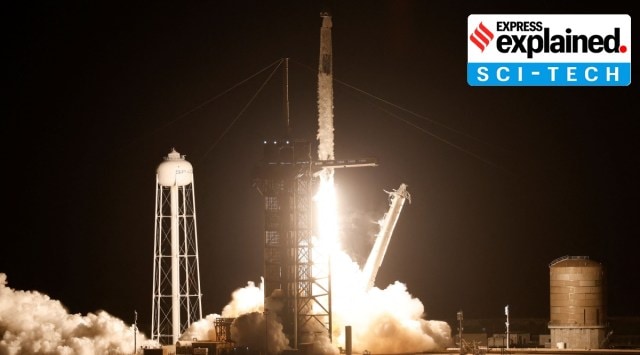NASA, SpaceX send astronauts from four nations to space station: Who are they, what is the mission
During their stay at the space station, the Crew-7 astronauts will conduct more than 200 science experiments and technology demonstrations to prepare for missions to the Moon, Mars, and beyond.
 A Falcon 9 rocket lifts off on NASA's SpaceX Crew-7 mission, taking four crew members to the International Space Station (ISS), from the Kennedy Space Center in Cape Canaveral, Florida, U.S., August 26, 2023. (Photo: Reuters/Joe Skipper)
A Falcon 9 rocket lifts off on NASA's SpaceX Crew-7 mission, taking four crew members to the International Space Station (ISS), from the Kennedy Space Center in Cape Canaveral, Florida, U.S., August 26, 2023. (Photo: Reuters/Joe Skipper) Four astronauts from four countries, including the US, Denmark, Japan, and Russia, launched aboard a SpaceX rocket towards the International Space Station (ISS) from NASA’s Kennedy Space Center in Florida on Saturday (August 26). This was the first US take-off in which all the astronauts atop the spacecraft belonged to a different country — until now, NASA had always included two or three of its own on its SpaceX flights.
Known as Crew-7, the mission includes NASA astronaut Jasmin Moghbeli, ESA (European Space Agency) astronaut Andreas Mogensen, JAXA (Japan Aerospace Exploration Agency) astronaut Satoshi Furukawa, and Roscosmos cosmonaut Konstantin Borisov. They are expected to reach the ISS on Sunday, replacing four astronauts living up there since March. The fresh batch of astronauts will stay at the ISS for the next six months and will conduct a host of different experiments.
Liftoff of Crew-7! pic.twitter.com/fvMpbvDPjU
— SpaceX (@SpaceX) August 26, 2023
“We’re a united team with a common mission,” Moghbeli, the mission commander, radioed from orbit. She added that her crew’s makeup demonstrates “what we can do when we work together in harmony.”
Who are the astronauts going to the ISS?
Born in Germany and raised on New York’s Long Island, Moghbeli is the daughter of an Iranian couple who had to flee their country during the 1979 revolution. The first-time space traveller earned a bachelor’s degree in aerospace engineering with information technology at the Massachusetts Institute of Technology (MIT) in Cambridge, following which she joined the Marines and flew attack helicopters in Afghanistan.
A Master of Science in aerospace engineering and graduate of the US Naval Test Pilot School, Maryland, Moghbeli was selected as a NASA astronaut in 2017. As the mission commander, she is responsible for all phases of flight, from launch to re-entry.
Mogensen is an ESA astronaut, who became the first Dutch person to go to space in 2015 — he was part of Russia’s Soyuz spacecraft for a 10-day mission to the space station. A doctorate in aerospace engineering from the University of Texas at Austin, Mogensen has also worked on oil rigs off the West African coast.
“He told people puzzled by his job choice that “in the future we would need drillers in space” like Bruce Willis’ character in the killer asteroid film Armageddon. He’s convinced the rig experience led to his selection,” the Associated Press reported. As the pilot on Crew-7, he is responsible for spacecraft systems and performance aboard the station.
Furukawa is on his second trip to space — he spent 165 days aboard the space station as part of Expeditions 28 and 29 in 2011. He worked as a surgeon for over a decade before making Japan’s astronaut cut in 1999.
Like Moghbeli, Borisov is also a first-time space traveller. An engineer turned businessman, the Russian runs a freediving school in Moscow and judges the sport, in which divers do away with oxygen tanks and hold their breath underwater. He joined the Roscosmos Cosmonaut Corps as a test cosmonaut candidate in 2018.
Why has such a diverse group of astronauts gone to ISS?
The Crew-7 mission is a result of the ongoing cooperation among different countries in space, especially since the launch of the space station in 1998. The International Space Station Program involves the US, Russia, Canada, Japan, and the participating countries of the European Space Agency, and is one of the most ambitious international collaborations ever attempted, according to NASA’s website.
The program “brings together international flight crews, multiple launch vehicles, globally distributed launch, operations, training, engineering, and development facilities; communications networks, and the international scientific research community,” it added.
What is the mission?
The Crew-7 is the eighth flight operated by NASA and Elon Musk-owned SpaceX as part of the agency’s commercial crew program, which has been taking astronauts to the ISS since SpaceX’s first crewed mission in 2020.
During their stay at the space station, the Crew-7 astronauts will conduct more than 200 science experiments and technology demonstrations to prepare for missions to the Moon, Mars, and beyond. The research will include a collection of microbial samples from the exterior of the space station. The team will also analyse how sleeping in the microgravity environment differs from Earth by examining astronauts’ brain waves while they sleep.
“Yet another experiment will look at the formation of biofilms in wastewater on the space station, which could be key to finding better ways to recycle water for drinking and hygiene while in space (Yes, astronauts have long used recycled sweat and urine to drink and shower on the station)”, CNN reported.
- 01
- 02
- 03
- 04
- 05






































